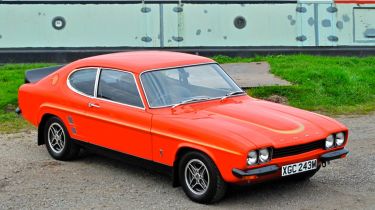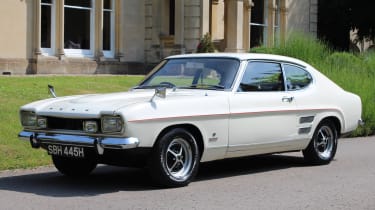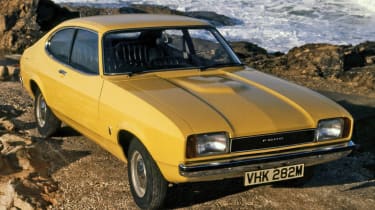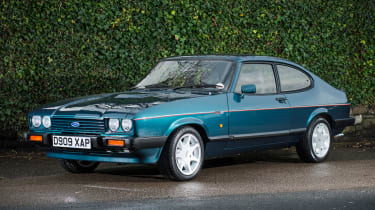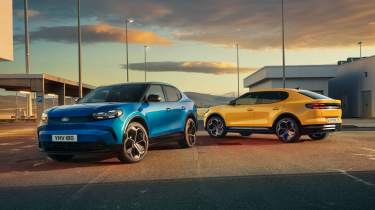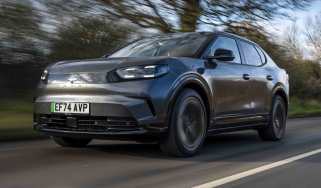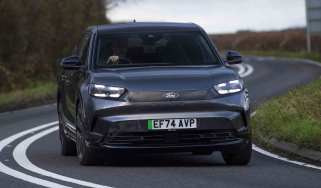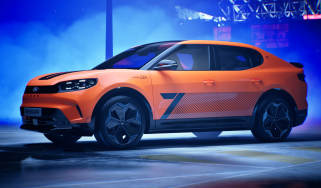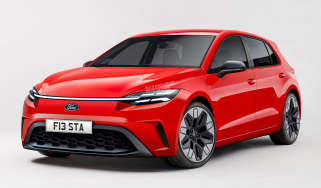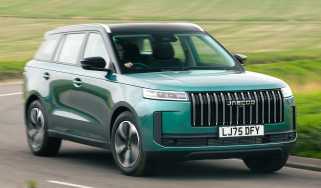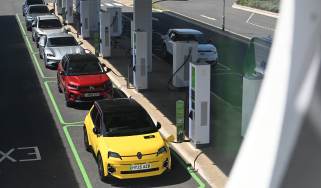History of the Ford Capri: models, specs and the controversial 2024 return
The Ford Capri retains a special place in the hearts of car fans. Over 50 years since its introduction, we look back at what made it great and what the future has in store for this motoring icon…
After seeing the runaway success of the Ford Mustang in the United States, Ford’s European divisions wanted to replicate the popularity of the ‘pony car’ for European markets. Engineers began work in 1966 focusing on creating a cheap, fast two-plus-two coupe, aimed at the blue-collar working man and in 1969 the Ford Capri was unveiled to the public for the first time.
Marketed under the tagline “the car you’ve always promised yourself”, the Ford Capri was a very successful model for Ford. Just under 2 million Ford Capri's in three generations rolled off the production line between 1969 and 1986, with almost half a million cars hitting the road within the first two years. Driven by its popularity and the desire within Ford to grow its profile further among buyers, the Ford Capri saw numerous updates through its lifetime and ended up in the hands of motorsport teams, police forces and car enthusiasts alike.
It’s been almost 40 years since production of the Mk3 Ford Capri ceased, but the Capri maintains a strong and loyal fan-base to this day. Ford has teased the potential return of the Capri nameplate at various points over the years, showing different concept cars and design sketches at motor shows around the world, but only now has the Ford Capri returned, albeit controversially, as an electric coupe-SUV.
With the Ford Capri nameplate returning to the road, we take a look back over the illustrious history of the Ford Capri from Mk1 to Mk4.
First generation Ford Capri (1969 – 1974)
The Capri entered its design phase in 1965, a collaborative effort between Ford’s German and British divisions. Originally due to be named the Colt (as a nod to its big brother and inspiration, the Mustang), it was penned to attract a younger audience, with its long bonnet, short tail and fake air vents in the rear wings.
Ford invested a total of £20 million in the project. The first car was completed in 1968, followed by a two-month production run prior to the official release date to ensure every Ford dealer forecourt had a Capri on show in time for its big debut. During this preliminary production run, Ford spent time in court with Mitsubishi, arguing about the rights to the Colt monika. Ford lost the case, forcing them to change the car’s name to the “Capri” for its official debut at the 1969 Brussels Motor Show.
Like the Mustang, which was built on the same platform as the more practical Ford Falcon saloon, the first-generation Capri was built on the same platform as the Mk2 Ford Cortina, in order to keep costs down. Priced at £890 from launch (or just over £12,500 today), it had a live axle with leaf-springs and drum brakes at the rear, MacPherson struts with disc brakes at the front and a four-speed all-synchromesh gearbox as standard.
Similar to the Mustang, the Ford Capri was offered with a wide range of engines. At the lower end of the range sat a 1.3-litre or a 1.6-litre Kent four-cylinder petrols, producing 53bhp and 64bhp respectively. These were followed by Ford’s 2.0-litre Essex V4 (with 93bhp) and the range-topping 138bhp 3.0-litre Essex V6, both of which made the Capri capable of speeds in excess of 100mph. The Capri was available with Ford’s 5.0-litre Windsor V8 although this was very limited in numbers and only available in South Africa.
From 1970, the Capri saw notable performances on the race track, with the final and fastest iteration, the RS3100, being entered into the European Touring Car Championship in 1974. ETCC homologation rules stated that 1,000 road-going RS3100s had to be built in order for the race car to be eligible, so Ford diligently set about the project.
Or, at least, so it claimed. In reality, Ford built no more than 250 examples of the Capri RS3100, as the 1973 oil crisis and waning consumer interest strangled sales. The road car was fitted with a de-tuned version of the race car’s 3.1-litre V6 engine, producing 148bhp and around 250Nm of torque. It featured vented disc brakes, lowered and stiffened suspension, a sports exhaust and a functional ducktail spoiler, meaning it was capable of sprinting from 0-60mph in 7.3 seconds and could reach a top speed of around 125mph.
Though under-appreciated in its day, the Capri RS3100 is now regarded as the best-performing and best handling version of the first-generation Capri and can easily command prices north of £40,000 on today’s classic car market. The most expensive Ford Capri - an RS3100 variant - sold for an eye-watering £74,250 when it went under the hammer in 2022.
Second generation Ford Capri (1974 – 1978)
In response to the 1973 oil crisis, Ford decided to modify the Capri’s design for the 1974 model year, making it into a car more suitable for everyday use. Revisions included a shortened nose, a more spacious cabin, a more practical clamshell rear hatch and a foldable rear bench seat, all of which made the Capri easier to manoeuvre and easier to live with. Hatchbacks were becoming increasingly popular around this time too, so to fight off competition, Ford adopted a hatchback rear door integrated into the tailgate, allowing for easier access to the boot space.
Ford also made the Capri easier to drive by softening its suspension, adding larger disc brakes for the front and providing buyers with the option of an automatic gearbox and power-assisted steering for the higher-specced models. The option of an automatic gearbox was a very popular among Ghia buyers and became standard-fit on all Ghia models after 1976.
For a car of its time, the Capri was relatively reliable. However, to remedy its charging issues, Ford gave the Mk2 Capri a standard-fit alternator in place of the Mk1’s dynamo and, to maintain its sporty look, “S” models and above got a new air-dam.
As part of the revisions, the second-generation Capri received a simplified engine range. The 3.1-litre V6 from the RS3100 was discontinued and the 2.0-litre Essex V4 was replaced by the more conventional 2.0-litre straight-four Pinto engine, with an improved output of 98bhp. The base model 1.3-litre and 1.6-litre Kent four-cylinders remained, and the 3.0-litre Essex V6 reclaimed its position as the range-topper.
However, the main change for the second-generation Capri was the way it was marketed. Ford introduced a range of trim-levels and specifications which appealed to a wider range of buyers, providing everything from a poverty-spec 1300L model (which included little more than an engine, four seats and a steering wheel), right up to the range-topping Ghia and “Midnight Capri” models, which featured unique paint finishes, alloy wheels and sports steering wheels.
Third generation Ford Capri (1978 – 1986)
Known affectionately as Project Carla, the Mk3 Capri began its design phase in 1976. Due to the project’s tight budget, it ended up being little more than a facelifted version of the Mk2, with updates being limited to a set of redesigned quad-headlights, a pair of new wings, a new bonnet, fresh bumpers and updated paint and interior options.
In all, Ford spent around £480,000 on the development of the third-generation Capri, which is small change in comparison to the £20 million worth of development allocated for the first-generation model a decade prior. To make up for the limited budget, Ford masked the Capri’s age through well-considered, cash-conscious trickery, repainting the Mk2’s chrome bumpers and exterior trim in a more contemporary satin black and using existing tooling to create the Mk3’s trademark “hooded” bonnet.
Also in the interest of saving money, the Mk2 Capri’s engine range was carried over to the Mk3 wholesale, helped along with a few minor improvements. For example, Ford updated its ageing 1.3-litre Kent engine with a new crossflow cylinder-head (replacing the previous model’s outdated reverse-flow head) and reshaped cylinder bores, which greatly improved reliability. The 3.0-litre Essex V6 also received a redesigned intake to prevent carburettor icing.
In 1981, increasingly stringent emissions regulations ousted the 3.0-litre Essex V6, which Ford replaced with a 2.8-litre fuel-injected V6 borrowed from the Granada. The reception to the new engine was good. Contemporary motoring journalists noted that, even though the Capri was priced to compete with the BMW 323i or Alfa Romeo Alfetta 2000 GTV of the day, its engine was larger, it was cheaper to maintain, it offered a more refined drive and it was faster.
The Capri remained on sale until 1986, with its sales gradually declining each year as drivers grew more strongly enticed by smaller, faster and more practical hot hatchbacks.
Fourth generation Ford Capri (2024 – )
In 2010, Ford flirted with the idea of reviving the Capri nameplate with a new Focus-based three-door hatchback coupe, designed to rival the Volkswagen Scirocco, but its plans didn’t progress past the initial stage of design. Fast forward to 2024 and, after an almost 40-year hiatus, Ford decided it was finally time to revive the Ford Capri nameplate.
Speculation that Ford was planning on reviving the Capri name began circulating in the first half of 2023. Early spy shots of this upcoming car under camouflage surfaced in November of the same year.
The Mk4 Capri was officially launched on 10 July 2024, and like previous generations of Capri, it borrows much of its running gear and technology from other cars – in this case its Ford Explorer SUV stablemate, as well as cars like the Skoda Enyaq and Volkswagen ID.5 – all of which share the same MEB platform from the Volkswagen Group.
Unlike Capri’s of old, the Mk4 Capri doesn’t have a wide variety of engines…or an engine at all for that matter. The new Capri is an all-electric car and is available with three different battery packs. From launch you could spec the Capri with a 79kWh or 77kWh battery with a maximum range of up to 390 miles for single-motor rear-wheel drive cars, or up to 348 miles for twin-motor cars.
While the latest Ford Capri might have moved away from the fastback two-door coupe recipe of the original, the Mk4 still has the performance credentials to back up its illustrious nameplate. Rear-drive single motor cars produce up to 282bhp, completing the 0-62mph dash in just 6.3 seconds. Twin-motor cars produce up to 335bhp and slash almost a second off the 0-62mph time.
If you were buying a Ford Capri when it launched in 1969, it would have cost the princely sum of £890, or just over £12,500 when adjusted for inflation. The Mk4 Capri costs a little more than that though, with a starting price of £48,075 for the entry level car and rising to £56,175 for the range-topping version.
Whatever you think of the latest car to carry the name, Ford Capri remains an icon - loved by enthusiasts and well worth its place in automotive history for the way it made sports coupe style and performance accessible to mainstream car buyers.
Have you ever owned a Ford Capri? Tell us about your experience in the comments section below…
Find a car with the experts

